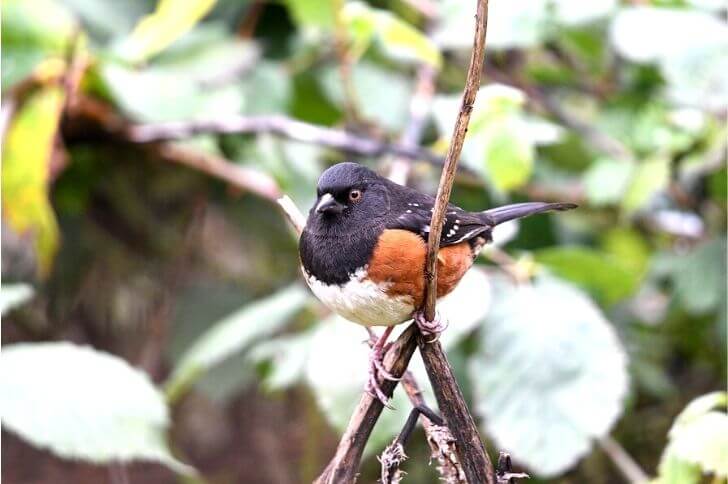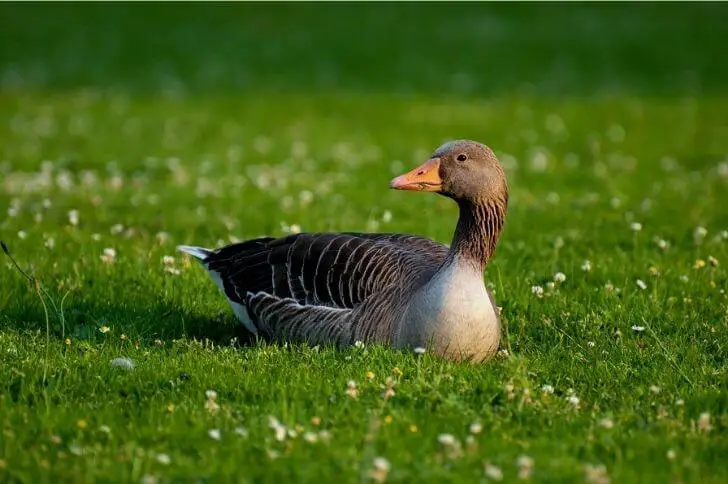Black birds with yellow bellies are becoming increasingly common in parts of the United States. Scientists aren’t sure why this is, but they suspect that it may have something to do with changing climatic conditions.
These species are a beautiful sight to see and if you are looking for a list to add to your birding journal, you are in the right place. We’ll discuss different yellow bellied birds, their habitat, color patterns and more.
List of Black Birds with Yellow Bellies
1. Scott’s oriole

Size:
Scott’s orioles are medium-sized North American passerine birds. They average 9.1 inches in length, 1.1-1.4 oz in weight with a wing length of 12.6 inches.
Plumage:
Stunning and unmistakable. Male have an all-black head, black back with white wing bars, and bright yellow underparts. Females are mostly brown with some lighter streaks on the back with pale yellow underparts.
Habitat & facts:
Scott’s orioles nest in trees, usually near water. The nest is a shallow cup made of grass, stems, and other plant material. 1-5 eggs are laid, and the incubation period is about 12 to 14 days. Both parents help feed the young birds.
The diet of the Scott’s oriole consists mainly of insects, but they will also eat fruit, especially oranges and seeds. These birds are found in open woodlands, parks, and gardens throughout most of North America east of the Rocky Mountains.
2. American goldfinch
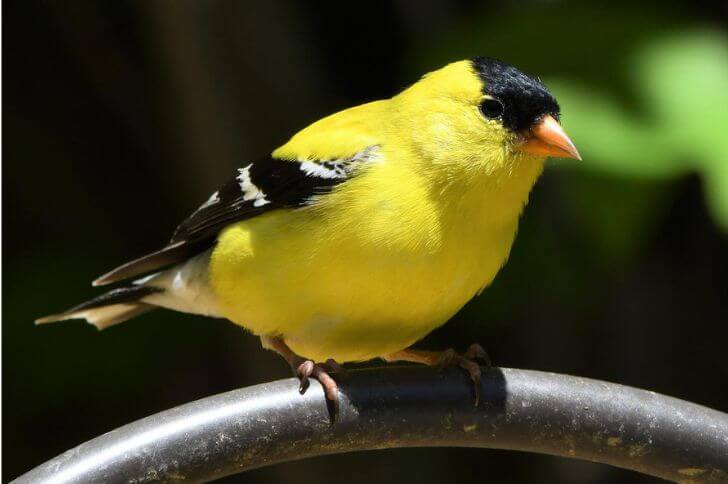
Size:
Small and common, the American goldfinch is an American songbird that is about 4.3 to 5.1-inch long and boasts a 7.5-8.7-inch wingspan.
Plumage:
Unlike other yellow bellied birds on this list, this species has a bright yellow body with black wings and tail. Females are duller below and olive green above while non-breeding males are brownish with black wings.
Habitat & plumage:
Spinus tristis or the American goldfinch is a small North American bird that is commonly found in open areas near trees. They eat a variety of seeds, fruits, and insects.
American goldfinches are one of the most common visitors to backyard bird feeders. They are known for their playful behavior, and can often be seen chasing each other around or singing together. These birds are also known for their long-distance migrations; some individuals have been documented traveling over 3,000 miles between North America and South America.
These birds with yellow bellies are known for their “per-twee-twee” sounds during flight and “po-to-to-chip” sounds that are interesting to listen to.
3. Western tanager

Size:
How big is a western tanager? It ranges 6.3-7.5 inches long with a 11.5 inches span and 0.8 oz in body mass. It’s slightly larger than the American sparrow but smaller than the blue jay.
Plumage:
Very distinctive, western tanagers are mostly yellow with a yellow-red head and dark wings and yellow wingbars. Female tanagers are olive green above and palish below.
Habitat & facts:
Western tanagers are members of the cardinal family. They are residents across much of western North America and parts of Alaska. They prefer mixed woods and coniferous forests.
The male sings a melodic warble to proclaim his territory and attract a mate. The female builds a cup-shaped nest out of grass, twigs, and moss, and lays four to five bluish eggs. The young hatch after about two weeks and are fed by both parents until they can fly three weeks later. Western tanagers feed on fruits such as figs and berries.
4. Evening grosbeak

Size:
Evening grosbeaks are medium-sized birds ranging 6.3-8.7 inches in length and spans 12-14 inches. A mature bird can weigh 1.9-2.6 oz.
Plumage:
How can I identify an evening grosbeak? Be on the lookout for a heavily beaked bird that has black wings with white patch, yellow belly, gray-black head, and yellow forehead. Females and young birds are mostly gray with thick triangular bills.
Habitat & facts:
Evening grosbeaks are usually seen in mixed and coniferous forests, where they forage for seeds and insects. They prefer seeds of maple, box elder, and ash trees.
Evening grosbeaks typically migrate south in the fall, but some may stay in the northern part of their range all winter. During the breeding season, females are known to lay 3-4 or 2-5 eggs that take 11 to 14 days to hatch. At about two weeks, juveniles leave the nest.
Related Read: Learn about white bellied black birds
5. Canada warbler

Size: 4.7-5.9 inches (12 to 15cm)
Wings: 6.7-8.7 inches (17 to 22cm)
Weight: 0.3-0.5 oz.
Canada warblers are small songbirds that can be found in deciduous and conifer forests across North America. These birds are most easily identified by their yellow chest with black streaks, dark back, yellow belly and legs.
They are known for their beautiful, melodic songs, which can be heard from early spring through late summer. Their notes include warbling notes and high-pitched chips.
Canada warblers typically nest in areas with dense ferns and shrubs. However, they are able to adapt to a wide variety of habitats, making them one of the most common warblers in North America.
Females weave cup-shaped nests from tree barks, moss, and grass. It takes them anywhere from three to five days to complete the nest. Then they lay 2 to 6 eggs with spots on shell.
These birds feed on a variety of insects, including caterpillars, beetles, and flies. They can often be seen perched on tree branches or high in the tops of trees, scanning for prey.
6. Audubon’s oriole
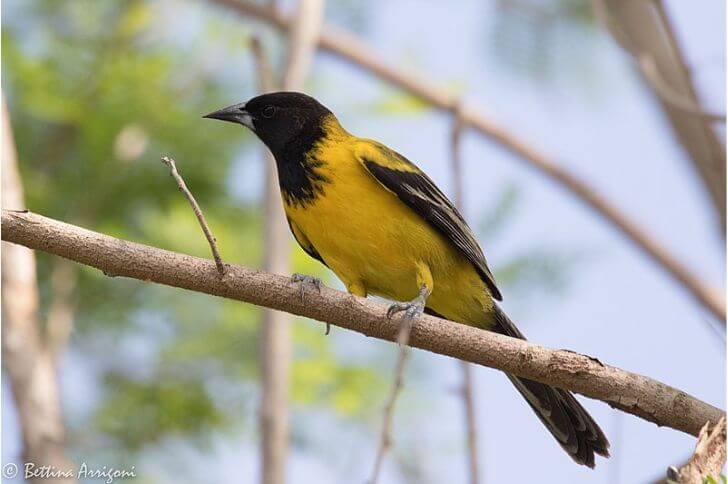
Source: Wikimedia.org
Size:
What bird lays white eggs with brown spots? Audubon’s orioles are migratory birds in North America that lay spotted eggs. These birds are 7.5 to 9.4 inches long with a span of 12.6 inches. An adult oriole can weigh up to 1.9oz.
Plumage:
These birds spot a black head, yellow breast, black and white wings, and a long gray tail. Both sexes share color patterns.
Habitat & facts:
These birds live in forests and woodlands, but can also be found in open areas near water. They eat insects, fruits, and seeds. Audubon’s orioles migrate south for the winter, but some stay in the southern United States year-round.
Females weave grass nests that hang in shallow branches. They lay 3-5 eggs and parents take turns incubating them. Their sounds include nasal “yehnk” or “nyyee” sounds.
7. Yellow bellied siskin
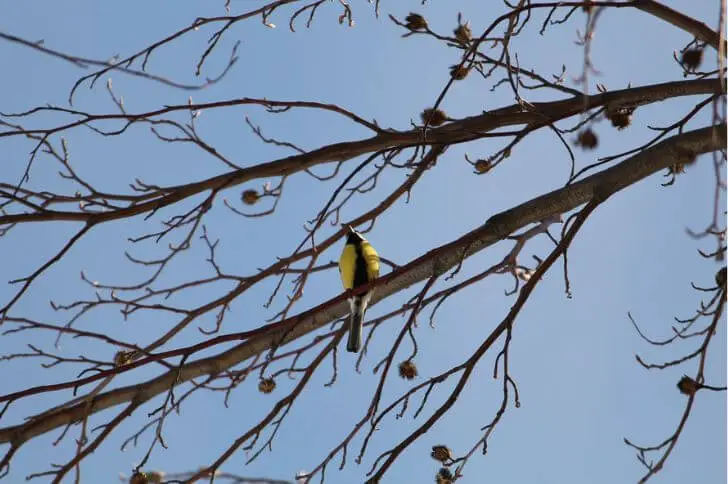
Size:
Looking for a small bird with yellow chest? Yellow-bellied siskins are about 4.1 inches long and about 0.4 oz in body mass.
Plumage:
From head, the upperparts, and tail, the bird is all black with bright yellow chests. Females and younger birds have an olive green back.
Habitat & facts:
Yellow bellied siskins are small passerine birds. They are a common breeder in open coniferous forests in some parts of South America.
These birds are very social, forming large flocks during the winter. During the summer they break up into pairs or small family groups. They eat seeds, insects, and fruit.
8. Blackburnian warbler
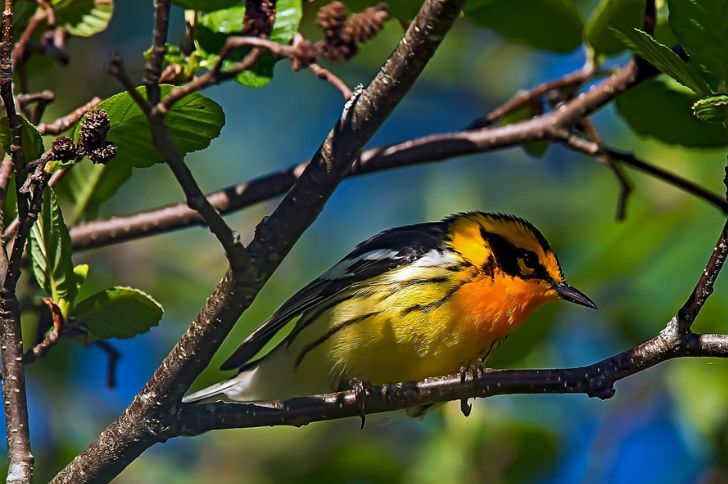
Size:
What’s the size of a blackburnian warbler? Around 4.3 to 5.1 inches in length, a span of 7.9 to 8.7 inches, and weight of 0.28 to 0.46 oz in body weight.
Plumage:
A must-see for every birding enthusiast. The male’s head has an intricate black and yellow stripe pattern that really stands out. Rest of the back is black with white wing bars with pale yellow underparts. Note the bright yellow face. Females and juveniles are duller.
Habitat & facts:
Want to attract black birds with yellow bellies to your backyard? Blackburnian warblers love a good bath. Installing a few bird feeders and bird baths will help attract these yellow-bellied birds to your home.
This warbler breeds in North America, typically in conifer-deciduous forests. During the winter, they can be found in the southeastern United States and Central America. Blackburnian warblers are migratory birds, and they travel long distances each year between their breeding and wintering grounds.
9. Black and yellow tanager

Source: sabrewing_nature_tours
Size:
Black and yellow tanagers are small yellow belly birds that are about 4.7 inches and weigh 0.4 oz.
Plumage:
Like other small yellow birds it spots a yellow head, breast and belly while the back and wings are all black. Females are olive green on their backs.
Habitat & facts:
The black and yellow tanager is a medium-sized Americas songbird. It is a very vocal bird, making a variety of calls including chirps, trills, and whistles. It feeds on insects, fruit, and nectar. The nest is a small cup of grasses, moss, or other materials placed in a tree or shrub.
Also read: Here are black birds with blue heads
10. Black and yellow grosbeak

Source: xshutter_up
Size:
Weighing just 2.3 oz, the black and yellow grosbeak is a 8.7 inch long bird that is a resident breeder in parts of the Indian subcontinent.
Plumage:
Easy-to-spot. Be on the lookout for a bird with bright yellow feathers below, black head and wings and a pale thick bill. Females are dark above and brownish below with heavy triangular bills.
Habitat & facts:
Preferring coniferous groves, these birds eat insects and seeds. They build their nests in trees or shrubs, using grass, twigs, and leaves. Black and yellow grosbeaks are usually seen singly or in pairs.
11. Yellow-bellied sapsucker

Size:
How big is a yellow-bellied sapsucker? About 7.1 to 8.7 inches in length, weighs 1.5-1.9 oz, and spans 13.4-15.8 inches.
Plumage:
Being a member of the woodpecker family, it shares similar color patterns. The adult has a red cap and throat, white and black back and yellowish below.
Habitat & facts:
This medium-sized bird is a member of the picidae or woodpecker family. They breed in coniferous forests across Canada and the eastern United States. It migrates to the southeastern United States for the winter.
The sapsucker feeds on sap from trees, as well as insects. It drills small holes in tree bark to extract sap, then uses its tongue to lap up the sap droplets.
They are cavity nesters, laying 4 to 6 whitish eggs. Nesting period lasts for up to thirty days.
12. Magnolia warblers

Size:
Magnolia warblers are part of the New world Warblers family. And like other members of this family they are about 4.3-5.1 inches in length, the same size as a house finch. Their weight varies from 0.23 to 0.44 oz.
Plumage:
Distinctive. Look out for a small bird with gray head, black mask, back, and wings and yellow-black belly. Females have a gray back.
Habitat & facts:
The magnolia warbler is a migratory bird that can be found in North America. They are known for their beautiful song, which has been described as a “rich flute-like melody.”
These black birds with yellow bellies typically breed in deciduous forests, but can also be found in pine forests and other types of woodland. During the winter, they can be found in tropical forests.
Other Yellow-bellied birds with Black (Outside US)
13. Red and yellow barbet
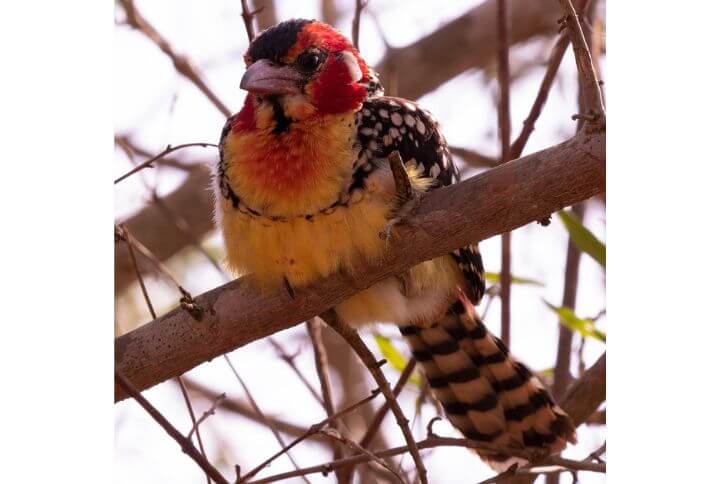
Size:
An adult red and yellow barbet is about 7.9 inches and weighs 1.4 to 2.6 oz.
Plumage:
Very beautiful. They have black white-spotted backs, red head and bill, and yellow belly.
Habitat & facts:
The red and yellow barbet is a small, bright bird found in Africa. They are typically found in open woodlands and savannas, where they feed on insects and fruit. Red and yellow barbets are social birds that often travel in flocks of 10-20 individuals. They are monogamous, and both the male and female take part in raising the young.
14. Yellow-bellied dacnis

Source: leonardopatrial_bahiabirding
Size:
Yellow-bellied dacnis are medium-sized, measuring about 5 inches long. It’s about the same size as a blue jay.
Plumage:
Males have black backs and wings with yellow shoulders, bright yellow chest and belly, and stunning red eyes. Females are tan below with brown upperparts. Their eyes are also red.
Habitat & facts:
The Dacnis flaviventer or yellow-bellied dacnis is a small passerine lowland forests from southern Mexico to northern Argentina. It is a member of the tanager family.
The song of this black bird with yellow belly is a series of loud whistles or trills uttered in flight or while perched conspicuously in an open area.
15. Yellow-rumped siskin

Source: dugab
Size:
A common bird in the Andes, the yellow-rumped siskin is a 5.3 inches long bird.
Plumage:
Upperparts, from head to tail feathers, are all black and the underparts are yellow from the chest to the undertail. Juvenile siskins are olive green above.
Habitat & facts:
The yellow-rumped siskin’s diet consists mainly of seeds, but the species will also eat insects and other small invertebrates. They are a non-migratory bird, spending their lives in Central America and northern South America.
16. Yellow-bellied flowerpecker

Size:
Sharp-looking and sexually dimorphic, yellow-bellied flowerpeckers are mid-sized birds; 4.3 to 5.1 inches in length.
Plumage:
They are a dull colored bird with black upper parts and feet. They are named for their distinctive yellow underbelly. Females are dark gray above.
Habitat & facts:
Yellow-bellied flowerpeckers are medium-size birds that are found in the rainforests of Southeast Asia. These birds are insectivores and feed on a variety of insects, including spiders, ants, and beetles.
They are also known to eat fruit and nectar. Yellow-bellied flowerpeckers are monogamous and form strong pair bonds. They build their nests out of plant material and lay 2-4 eggs.
17. Black and yellow silky flycatcher
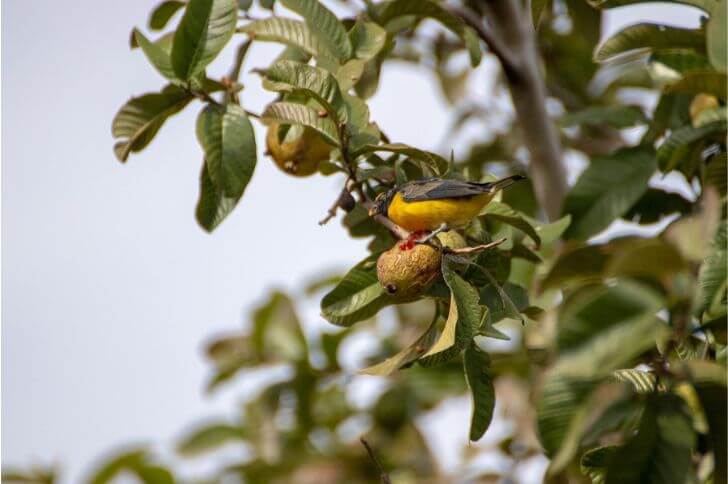
Size:
How long is a black and yellow silky flycatcher? These yellow belly black birds are about 5.3 inches in length.
Plumage:
Males are black above with a bright yellow rump. Their bellies are gray-yellow. Female silky flycatchers are olive gray above with pale yellow underparts.
Habitat & facts:
Found in parts of Costa Rica, these mid-sized birds were first described in 1877 by English ornithologist Salvin. This bird species is known to build bulky nests where females lay 2-3 greyish-white eggs.
18. Yellow-bellied hyliota

Found in parts of Africa, yellow-bellied hyliota are mid-sized birds found in parts of Africa. The species is sexually dimorphic, with the males being mostly black with white wing patch while the females are brown or olive-green. Both sexes have a distinctive yellow patch on their bellies.
The yellow-bellied hyliota is a shy and retiring species that typically inhabits dense vegetation in open woodland, scrubland, and forest edges. It is an insectivore, feeding on a variety of insects and spiders.
19. Yellow-bellied longbill
Yellow-bellied longbills or the Toxorhamphus novaeguineae are small birds that favor tropical lowland forests. This species is similar in appearance to the western tanager, but can be distinguished by its long curved beak.
These small yellow birds are a common bird, and can be found in a variety of habitats, including woodlands, gardens, and open fields. This species prefers nectar but will also feed on insects caught on the ground or gleaned from trees and shrubs. The yellow-bellied longbill is a social bird, typically occurring in pairs or small flocks.
20. Yellow-bellied tit

Yellow-bellied tits are part of the tit family, Paridae. They are found in temperate forests of Asia.
The adult yellow-bellied tit has a black cap and nape, white cheeks and throat. The rest of the body is yellow. Females are duller than males. This bird is about 4.7 inches long and weighs about 0.4 oz. These birds are smaller compared to other birds in their family.
21. Black and yellow tanager
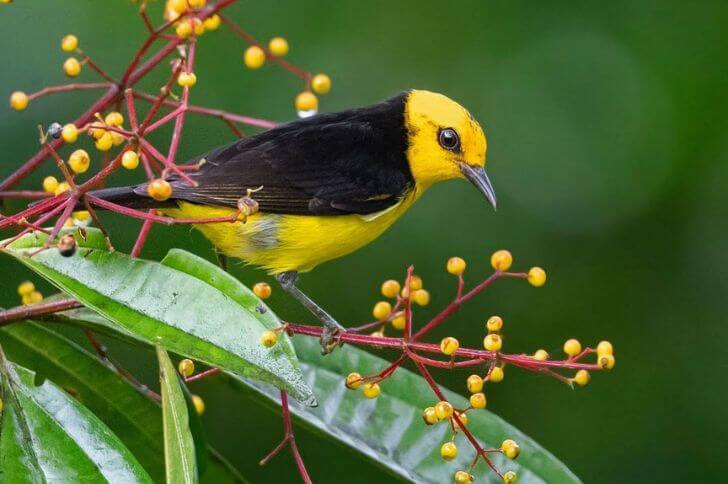
Black and yellow tanagers are South American birds that are found in the rainforest. They are small birds, with a body length of about five inches. The plumage of the male tanager is striking, with black wings and tail, and a bright yellow head and chest. The female is duller in color, with olive-green wings and a pale yellow chest.
These birds are insectivores, and feed on insects found in the trees of the rainforest. They are monogamous, and build their nests together from plant material.
22. Yellow-tailed oriole

The yellow-tailed oriole is a New World bird that is from the family Icteridae which also includes blackbirds and meadowlarks. They are about 10 inches in length, and have a wingspan of about 16 inches. The bird is mostly yellow with black wings and throat. Sexes look similar, but you’ll notice the females are a bit duller.
The yellow-tailed oriole is a migrant species, meaning that it migrates to different areas depending on the season.
23. Brown and yellow marshbird

Brown and yellow marshbirds are a robin-sized bird that can be found in marshes and wetlands throughout South America. This bird is easily identified by its distinctive brown and yellow coloring, which helps it blend in with the marshland environment.
The brown and yellow marsh bird feeds on insects and other small invertebrates, which it typically finds by foraging through the water or grasses near the edge of a marsh.
Hi, my name is Steve. My friend and I started the spanishbirdguides.com to share our passion with other like-minded people. So, if bird watching is your thing, you’ll love this blog. I’ll share what I’ve learnt about both local birds and those found in other parts of the world. Also, I’d love to hear your experiences.
